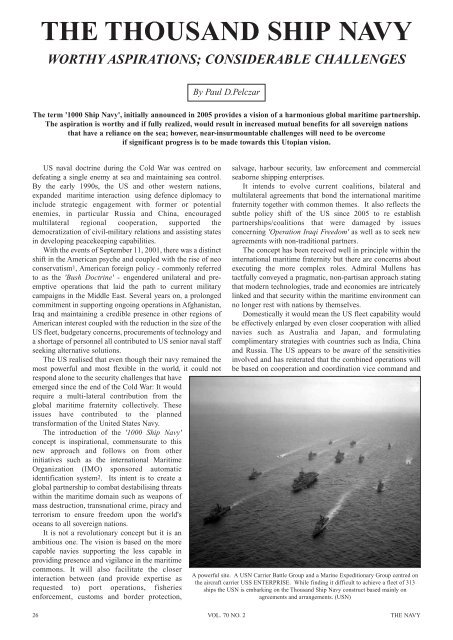The Navy Vol_70_No_2 Apr 2008 - Navy League of Australia
The Navy Vol_70_No_2 Apr 2008 - Navy League of Australia
The Navy Vol_70_No_2 Apr 2008 - Navy League of Australia
Create successful ePaper yourself
Turn your PDF publications into a flip-book with our unique Google optimized e-Paper software.
THE THOUSAND SHIP NAVY<br />
WORTHY ASPIRATIONS; CONSIDERABLE CHALLENGES<br />
By Paul D.Pelczar<br />
<strong>The</strong> term '1000 Ship <strong>Navy</strong>', initially announced in 2005 provides a vision <strong>of</strong> a harmonious global maritime partnership.<br />
<strong>The</strong> aspiration is worthy and if fully realized, would result in increased mutual benefits for all sovereign nations<br />
that have a reliance on the sea; however, near-insurmountable challenges will need to be overcome<br />
if significant progress is to be made towards this Utopian vision.<br />
US naval doctrine during the Cold War was centred on<br />
defeating a single enemy at sea and maintaining sea control.<br />
By the early 1990s, the US and other western nations,<br />
expanded maritime interaction using defence diplomacy to<br />
include strategic engagement with former or potential<br />
enemies, in particular Russia and China, encouraged<br />
multilateral regional cooperation, supported the<br />
democratization <strong>of</strong> civil-military relations and assisting states<br />
in developing peacekeeping capabilities.<br />
With the events <strong>of</strong> September 11, 2001, there was a distinct<br />
shift in the American psyche and coupled with the rise <strong>of</strong> neo<br />
conservatism1, American foreign policy - commonly referred<br />
to as the 'Bush Doctrine' - engendered unilateral and preemptive<br />
operations that laid the path to current military<br />
campaigns in the Middle East. Several years on, a prolonged<br />
commitment in supporting ongoing operations in Afghanistan,<br />
Iraq and maintaining a credible presence in other regions <strong>of</strong><br />
American interest coupled with the reduction in the size <strong>of</strong> the<br />
US fleet, budgetary concerns, procurements <strong>of</strong> technology and<br />
a shortage <strong>of</strong> personnel all contributed to US senior naval staff<br />
seeking alternative solutions.<br />
<strong>The</strong> US realised that even though their navy remained the<br />
most powerful and most flexible in the world, it could not<br />
respond alone to the security challenges that have<br />
emerged since the end <strong>of</strong> the Cold War: It would<br />
require a multi-lateral contribution from the<br />
global maritime fraternity collectively. <strong>The</strong>se<br />
issues have contributed to the planned<br />
transformation <strong>of</strong> the United States <strong>Navy</strong>.<br />
<strong>The</strong> introduction <strong>of</strong> the '1000 Ship <strong>Navy</strong>'<br />
concept is inspirational, commensurate to this<br />
new approach and follows on from other<br />
initiatives such as the international Maritime<br />
Organization (IMO) sponsored automatic<br />
identification system2. Its intent is to create a<br />
global partnership to combat destabilising threats<br />
within the maritime domain such as weapons <strong>of</strong><br />
mass destruction, transnational crime, piracy and<br />
terrorism to ensure freedom upon the world's<br />
oceans to all sovereign nations.<br />
It is not a revolutionary concept but it is an<br />
ambitious one. <strong>The</strong> vision is based on the more<br />
capable navies supporting the less capable in<br />
providing presence and vigilance in the maritime<br />
commons. It will also facilitate the closer<br />
interaction between (and provide expertise as<br />
requested to) port operations, fisheries<br />
enforcement, customs and border protection,<br />
salvage, harbour security, law enforcement and commercial<br />
seaborne shipping enterprises.<br />
It intends to evolve current coalitions, bilateral and<br />
multilateral agreements that bond the international maritime<br />
fraternity together with common themes. It also reflects the<br />
subtle policy shift <strong>of</strong> the US since 2005 to re establish<br />
partnerships/coalitions that were damaged by issues<br />
concerning 'Operation Iraqi Freedom' as well as to seek new<br />
agreements with non-traditional partners.<br />
<strong>The</strong> concept has been received well in principle within the<br />
international maritime fraternity but there are concerns about<br />
executing the more complex roles. Admiral Mullens has<br />
tactfully conveyed a pragmatic, non-partisan approach stating<br />
that modern technologies, trade and economies are intricately<br />
linked and that security within the maritime environment can<br />
no longer rest with nations by themselves.<br />
Domestically it would mean the US fleet capability would<br />
be effectively enlarged by even closer cooperation with allied<br />
navies such as <strong>Australia</strong> and Japan, and formulating<br />
complimentary strategies with countries such as India, China<br />
and Russia. <strong>The</strong> US appears to be aware <strong>of</strong> the sensitivities<br />
involved and has reiterated that the combined operations will<br />
be based on cooperation and coordination vice command and<br />
A powerful site. A USN Carrier Battle Group and a Marine Expeditionary Group centred on<br />
the aircraft carrier USS ENTERPRISE. While finding it difficult to achieve a fleet <strong>of</strong> 313<br />
ships the USN is embarking on the Thousand Ship <strong>Navy</strong> construct based mainly on<br />
agreements and arrangements. (USN)<br />
26 VOL. <strong>70</strong> NO. 2 THE NAVY

















